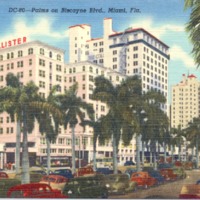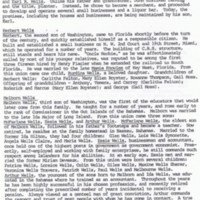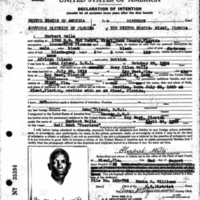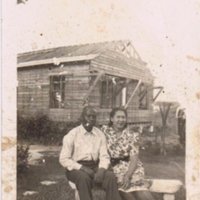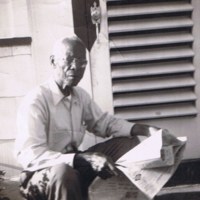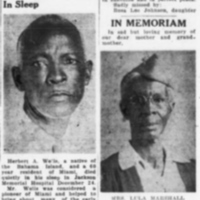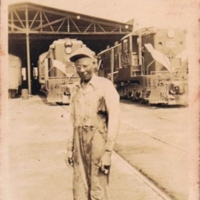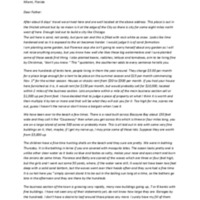Miami Collection
Dublin Core
Title
Miami Collection
Alternative Title
Miami Collection
Subject
Collection of archival items related to the history of Miami, Florida. The Tequestas were the first known inhabitants of the Miami area before explorer Pedro Menéndez de Avilés (1519-1574) claimed the land in 1566 for Spain, which established a mission there the following year. After Spain ceded the Florida Territory in 1821, the U.S. constructed Fort Dallas, which served as an important battlefront during the Second Seminole War. For much of the 19th century, Miami remained a region of wilderness, and it was one of the few area's to survive the Great Freeze of 1894 with relatively few damages. Soon after, Henry Flagler (1830-1913) expanded his Florida East Coast Railway (FEC) to the area, and Miami was officially incorporated as a city on July 28, 1896.
Like other parts of Florida, Miami prospered during the Florida Land Boom of the 1920s, but also floundered when the real estate bubble burst in 1925. The following year, the Great Miami Hurricane of 1926 devastated South Florida and the Great Depression began just three years later. During World War II, Miami played a vital role in battling German submarines, resulting in increased population growth in the post-ward period. Miami experienced another spurt in population growth when hundreds of thousands of people fled Cuba, following the takeover by Fidel Castro (1926-). Despite a number of social crises in the 1980s and 1990s, Miami remains a major international, financial, and cultural center.
Like other parts of Florida, Miami prospered during the Florida Land Boom of the 1920s, but also floundered when the real estate bubble burst in 1925. The following year, the Great Miami Hurricane of 1926 devastated South Florida and the Great Depression began just three years later. During World War II, Miami played a vital role in battling German submarines, resulting in increased population growth in the post-ward period. Miami experienced another spurt in population growth when hundreds of thousands of people fled Cuba, following the takeover by Fidel Castro (1926-). Despite a number of social crises in the 1980s and 1990s, Miami remains a major international, financial, and cultural center.
Is Part Of
Miami-Dade County Collection, RICHES of Central Florida.
Language
eng
Type
Collection
Coverage
Miami, Florida
Curator
Cepero, Laura
Digital Collection
External Reference
"City of Miami History." City of Miami. http://www.miamigov.com/home/history.html.
"MIAMI: ONE HUNDRED YEARS OF HISTORY." HistoryMiami. http://www.historymiami.org/research-miami/topics/history-of-miami/.
Collection Items
Palms on Biscayne Blvd. Postcard
A postcard depicting palm trees along Biscayne Boulevard in Downtown Miami, Florida. The most prominent building in this postcard is one of Miami's first skyscrapers, McAllister Hotel, located at 10 Biscayne Boulevard. Designed by Walter De Garmo…
Offspring: Washington Wells
A page from a family biography the Wells of the Bahamas. This particular page shows the offspring of Washington Wells, who was an Afro-Bahamian planter during the mid-19th century: John Wells (1866-1941), Herbert Alexander Wells (1882-1960), and…
Declaration of Intention for Herbert Alexander Wells
A Declaration of Intention for Herbert Alexander Wells (1882-1960), the first African American hired by the Florida East Coast Railway Company (FEC). A Declaration of Intention was required for the naturalization of immigrants.Born in the Bahamas in…
Cary Marshall and Martha Marshall
Cary Marshall and Martha Marshall in the yard of their home in the Liberty City neighborhood of Miami, Florida. Cary worked at the Indian Creek Golf Club in Miami Beach. Martha also worked in Miami Beach, for a local attorney. Their neighbor's house,…
Herbert Alexander Wells
Herbert Alexander Wells (1882-1960), the first African American hired by the Florida East Coast Railway Company (FEC), in front his home in the Liberty City neighborhood of Miami, Florida. Born in the Bahamas in 1882, Wells migrated to Key West,…
Herbert Wells Dies in Sleep
An obituary for Herbert Alexander Wells (1882-1960), the first African American hired by the Florida East Coast Railway Company (FEC). Born in the Bahamas in 1882, Wells migrated to Key West, Florida, via the Fearless in 1900 and began working for…
Herbert Alexander Wells at the Railyard in Savannah, Georgia
Herbert Alexander Wells (1882-1960), the first African American hired by the Florida East Coast Railway Company (FEC), at the railyard in Savannah, Georgia. Born in the Bahamas in 1882, Wells migrated to Key West, Florida, via the Fearless in 1900…
Letter from Carl Arvil Mead to Oscar Winfield Mead
A letter from Carl Arvil Mead to his father, Oscar Winfield Mead, most likely written the winter of 1920 when Carl Mead and his family were in Miami, Florida. He was from Walton, Indiana and his father was from Pekin. In the letter, Carl Mead…
Collection Tree
- Miami-Dade County Collection
- Miami Collection
